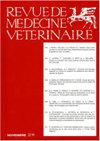Accidental Poisoning with Nerium Oleander in Goat dairy in the Santiago Metropolitan Region in Chile
Q2 Veterinary
引用次数: 1
Abstract
How to cite this article: Flores Olivares C, Morada Muñoz C, López Eldredge F, Pinto Morales J, Navarrete Figueroa L, Rodríguez Latorre C, et al. Accidental poisoning with Nerium oleander in dairy goat in the Santiago Metropolitan Region in Chile. Rev Med Vet. 2019;(39):43-48. https://doi.org/10.19052/mv.vol1.iss39.4 * Artículo resultado de investigación. 1 Veterinarian. Spc. Animal Health, Laboratorio de Patología Veterinaria Universidad Mayor, Santiago de Chile. carlos.flores@umayor.cl; flores. carlos.vet@gmail.com https://orcid. org/0000-0002-7837-3849 2 Veterinarian, School of Veterinary Medicine, Faculty of Sciences, Universidad Mayor, Santiago de Chile. 3 Histotechnologist. Spc. Morphophysiopathology and cytodiagnosis, School of Veterinary Medicine, Faculty of Sciences, Universidad Mayor, Santiago de Chile. 4 Veterinarian, School of Veterinary Medicine, Faculty of Sciences, Universidad Mayor, Santiago de Chile. 5 Student of Veterinary Medicine, School of Veterinary Medicine, Faculty of Sciences, Universidad Mayor, Santiago de Chile. 6 Student of Veterinary Medicine, School of Veterinary Medicine, Faculty of Sciences, Universidad Mayor, Santiago de Chile. 7 Student of Veterinary Medicine, School of Veterinary Medicine, Faculty of Sciences, Universidad Mayor, Santiago de Chile. 8 Veterinarian, Master in Biomedicine, School of Veterinary Medicine, Faculty of Sciences, Universidad Mayor, Santiago de Chile. Abstract A small dairy goat farm in central Chile stocked their troughs with ornamental plants and grasses, which were obtained after pruning the gardens of neighboring sectors. Twelve hours after the goats ingested this food, the farm registered a death toll of eight goats, all of which were adult females in their productive stage, before entering the milking parlor. The mortality episode lasted 84 hours and produced mortality and morbidity values of 48 and 54 percent, respectively (n = 52). During a visit to the farm, clinic inspections, autopsies, and sample tissues were obtained for microscopic analysis (the tissues specimens were fixed in 10% buffered formaldehyde solution). The clinic inspection and microscopic analysis both confirmed that the animals had cardiovascular disease. The lesions were compatible with those produced by cardiac glycosides. During the site visit, Nerium oleander was found in the troughs, which suggested that the animals were poisoned by eating this plant. There was a high presence of this plant in the poisoned area, and it was not associated with the mortality episode before the on-site visit, which indicates that the authors should conduct training and inform producers about the handling and feeding of their animals.智利圣地亚哥市区山羊奶牛场发生夹竹桃意外中毒事件
如何引用这篇文章:Flores Olivares C, Morada munoz C, lopez Eldredge F, Pinto Morales J, Navarrete Figueroa L, rodriguez Latorre C等。意外poisoning with Nerium打倒in乳品goat in the Metropolitan Region in智利圣地亚哥。(39):43-48。https://doi.org/10.19052/mv.vol1.iss39.4 *研究成果文章。1 Veterinarian。最高人民法院。智利圣地亚哥市长大学动物卫生兽医病理学实验室。carlos.flores@umayor.cl;鲜花。carlos.vet@gmail.com https://orcid。2名兽医,智利圣地亚哥市长大学理学院兽医学院。3名组织技术专家。最高人民法院。Morphophysiopathology and cytodiagnosis,兽医医学学院(Faculty of Sciences)、大学、智利圣地亚哥。4 Veterinarian、兽医医学学院(Faculty of Sciences)、大学、智利圣地亚哥。5医学of兽医,兽医医学学院,学生Faculty of Sciences)、大学、智利圣地亚哥。6医学学生of兽医,兽医医学学院Faculty of Sciences)、大学、智利圣地亚哥。7名兽医学生,智利圣地亚哥市长大学理学院兽医学院。8名兽医,生物医学硕士,智利圣地亚哥市长大学理学院兽医学院。= = references = = = =外部引用= = = =外部引用= = = =外部引用= = = =外部引用= = = =外部引用= = = =外部引用= = = =外部引用= = = =外部引用= = = =外部引用= =after the Twelve小时goats ingested this food, the农场registered a toll of八goats死刑,all of which成人夜班女工的供资情况之前的阶段,entering the milking parlor。死亡事件持续84小时,死亡率和发病率分别为48%和54% (n = 52)。在访问农场、临床检查、尸检和采集组织样本进行显微镜分析期间(组织样本固定在10%的甲醛溶液中)。= =地理= =根据美国人口普查,这个县的面积为,其中土地面积为。有关lesions兼容相对生产的by cardiac glycosides。= =地理= =根据美国人口普查,这个县的土地面积为,其中土地面积为。在有毒地区,这种植物的存在程度很高,在现场访问之前,它与死亡事件没有联系,这表明作者应该对其动物的处理和喂养进行培训和通知生产者。
本文章由计算机程序翻译,如有差异,请以英文原文为准。
求助全文
约1分钟内获得全文
求助全文
来源期刊

Revue De Medecine Veterinaire
农林科学-兽医学
CiteScore
1.30
自引率
0.00%
发文量
0
审稿时长
18-36 weeks
期刊介绍:
The Revue de Médecine Vétérinaire publishes four kinds of text:
1) Scientific reviews on subjects related to veterinary and comparative medicine. Suggested length: 10 to 30 typed pages.
2) Original reports on fundamental or applied research. Suggested length: 10 to 15 typed pages.
3) Continuous education articles, that should be easily understandable by non-specialists. Suggested length: 10 to 15 typed pages.
4) Clinical reports. Suggested length: 5 to 15 typed pages.
The publication can be done in French language or English language.
For an article written in English by not english native speakers authors, the manuscript must be subjected by attesting that it was read again by an anglophone scientist or a scientific translator.
The authors must certify that the manuscript was not published or subjected for publication to another review.
The manuscript must be accompanied by a sheet signed by all the joint authors indicating their agreement for the tender of the manuscript.
The publication is free but a financial participation could be required for the photographs color. An estimate will be sent to collect the agreement of the authors.
 求助内容:
求助内容: 应助结果提醒方式:
应助结果提醒方式:


